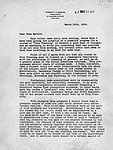 Beginnings of the program. |
Professor Everett V. Meeks introduced the program in city planning at
Cornell with his 1918 lectures on the history of planning. Beginning in 1931, nonresident
lecturers presented a special series on city planning. By 1935, when Gilmore D. Clarke
joined the faculty, interest in planning courses increased. With the help of a grant from
the Carnegie Corporation, Clarke expanded the lecture series. With further Carnegie
support, Thomas Mackesey developed courses in planning history, zoning, and fieldwork. The
Colleges of Architecture and Engineering gave instruction on a cooperative basis. While
the courses were not originally intended to lead to a degree in planning, in 1941 the New
York State Regents approved the formal master’s degree program. Initially, most
planning students were Cornell architecture graduates who could complete the master’s
program in one year, but after World War II enrollment was boosted by students from other
fields and schools, as well as international students. In 1952 John Reps (M.R.P. ‘47)
received a full-time appointment as the first chairman of the new Department of City and
Regional Planning. The new program enrolled seven students, and required courses from
other colleges on campus to provide a more rounded education.
The 1960s saw growth on every front. Planning practice and education expanded with the
development of greater social awareness. Enrollment increased to about eighty students and
the college added several professors with degrees in the social sciences. The department
emphasized community assistance, outreach, and research activities. The first course in
historic preservation was offered in 1963. A Cornell-Yugoslavia project and a graduate
program in planning at the University of Puerto Rico gave Cornell an international
presence. City and Regional Planning added three major programs to the graduate curriculum
in the 1970s—international studies, regional science, and historic
preservation—as well as an undergraduate program in urban and regional studies. |

